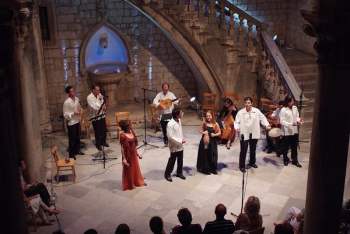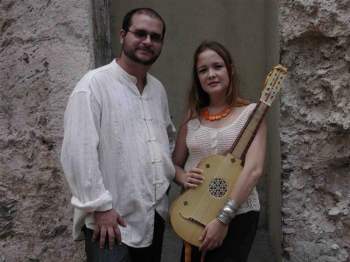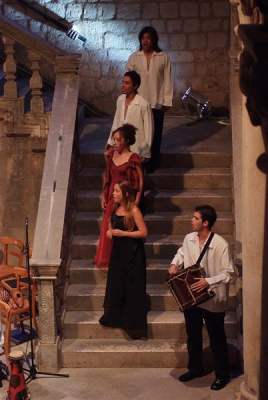Ancient Music Made in Cuba from Ars Longa
By Helson Hernandez

HAVANA TIMES, June 24 — HT interviews soprano Teresa Paz, the director of ancient music group Ars Longa. As she noted, “Our group occupies a tremendous place within the context of defending Cuba’s musical legacy!”
HT: What were the precedents to the formation of Ars Longa?
TERESA PAZ: The group is 17 years old, but only now am I writing a kind of thesis on the work of Ars Longa; how our group has been salvaging and sharing our ancient musical legacy. Now I’m having to go back to everything concerning what the group has worked on, how we began, what were the origins of ancient music in Cuba at that time, what was done, what we lacked, that’s to say what place the group occupied within the context of defending Cuba’s musical heritage.
And it’s really been interesting because we’re recalling all the things we did in the beginning. We began in 1994, and by ’95 we were already premiering our work at the International Choir Festival, which is one of the most important events that concert music has on the island. The City Historian’s Office, with the emblematic figure of Eusebio Leal, upholds not only the construction of our physical patrimony, but the non-physical creations as well. That’s where we’re found, filling all those places of the Havana’s historic district with the sound that’s needed among the bricks and mortar.
HT: I imagine that it hasn’t been easy to establish oneself working with “ancient music,” reviving so many epochs of the past and rescuing almost forgotten musical works.
TERESA PAZ: No it hasn’t. In the work of ancient music, musicology is very important. These days it’s a specialty that can be defined as the science of music, and it’s rapidly gaining in importance right now. Research is decisive for a musician who works with not only repertoires of the Middle Ages or Baroque, but also with composers like Beethoven, Mozart, and others, since the musicologist serves to locate them in their contexts.
Through all the research that brings them closer to these times, there will always be the aim of performing much more like in the past, but that can’t be done without knowing those historical references. That’s why I’m telling you that working with a musicologist in this art form is vitally important.
In our case we’ve worked with the musicologist Miriam Escudero since 1997, when we had our first contact with her starting from a concert that was done around a book of hers. She had received the Casa de las Americas award for that work cataloging all the music that appeared in the Mercedes Church.
First there was that concert and later it became a CD that brought together several composers from the 19th century who we had given up for lost. This was the first encounter where we confirmed the need for the musicologist-performer relationship. This was because there were transcribed works with which this specialist also had the mission of completing passages that are blurred or missing on the scores, perhaps deteriorated by the course of time. The musicologist had the trying task of coming as close as possible to the original composer’s ideas in recreating what that artist wanted to express in their work.
HT: What is Teresa Paz’s background? Where does she come from?

TERESA PAZ: Well, I studied choir directing; from the elementary level I was trained in Guantanamo Province. I want people to know that choir directing is one of the most complete specialties that’s studied in music, because you have to do many things, like playing the piano, where you must approach the whole choral repertoire with that instrument. It gives you many opportunities to learn polyphonous techniques like counterpoint. It’s very interesting because it requires you to make a deep musical analysis and later that serves to raise the levels of your students, which in turn allows them to approach their own careers with a more solid foundation.
HT: And specifically canto lirico?
TERESA PAZ: Well, I didn’t study canto lirico (opera singing) academically like the other specialties I already spoke about. It was only that since our years as students we were always singing and I was very concerned about learning vocal technique. Also, in the study of choral direction we studied singing, and I loved approaching the works of recognized masters who later wound up working for a long time with Ars Longa, people like Adolfo Houses. They helped us to learn a technique that later allowed the members of the group to approach certain repertoires.
We knew techniques for singing in choirs but we developed our roles as soloists through practice, though we now have singers who graduated from the Superior Institute of Art. We members of Ars Longa have been concerned about strengthening our singing technique; we really study all forms of Baroque, where they’re sung in operas and oratories. Still though, having a technique that allows you to approach all this is very difficult.
HT: Ars Longa conceives of its performances with the concept of a spectacle — a show — recreating as closely as possible the complete atmosphere of the epoch to which the music belongs.
TERESA PAZ: I’ve always been interested in not only approaching the music in itself. When I began to work with Ars Longa I felt that my projection as an artist had a lot to do with all that was happening. Then, since we’re under the Office of the City Historian, all those wonderful spaces that invite people to recreate the spirit of a past epoch, they really came to form the ideal of my artistic aim.

That is what we’ve done, for example, when we’ve performed at the Real Fuerza Castle in Havana, attempting to recreate what happened in such a palace or a castle. We’ve worked on pieces specifically written for theater like “El Festino,” which we premiered in the Government Palace of Old Havana since it’s a place that resembles the epoch that this work narrates; that was the epoch between the Renaissance and the Baroque period. It was a way to find the music in the space and to unite everything that was needed so that people could capture that spirit and travel back into other ages.
HT: You were the first group in Cuba to approach “ancient music.”
TERESA PAZ: Yes, that’s true. I don’t know of the existence of another group that only approached these repertoires prior to Ars Longa. These songs were played by other orchestras, but the concept of performance is what made us the pioneering group of this activity in Cuba. This was because, for example, our musical instruments marked our difference, because it’s not the same thing to play a sonata by Corelli or Vivaldi on a violin given the characteristics of that instrument which existed in the baroque period than another that’s not that of the epoch. That already supposes a different sonority.
Ars Longa operates under the auspices of the Historian’s Office, and thanks to that we are provided with the musical instruments required to play the music of each epoch with the most original sonority possible. That office also helps us to become familiar with all the information, to read the tracts, to know how they were sung, to know how the trills were… That’s why this music is now called “informed historical interpretation,” which is to say that it has all the information possible to recreate the original repertoire.
HT: So we can say that your musical project has been an inspiration so that later on other groups would appear on the island to cultivate this musical style.
TERESA PAZ: In Cuba there now exist other followers of this work. I can point to El Gremio here in Havana, whose main director was a member of Ars Longa. In the city of Villa Clara there is Ars Nova, and in Bayamo there’s another group called Exulten. Our group has created a festival that we organize every year and that has been the fundamental nucleus for promoting an interest by all these groups to create these repertoires.
HT: Concerning the instruments that you use, and which define the style of the group, they seem very specific and therefore difficult to obtain given their age.

TERESA PAZ: Well yes, in the case of the celo, we have an original instrument from the 18th century, and the other instruments are copies of originals that have been acquired through very expensive purchases of course.
HT: Don’t there exist — even for Ars Longa — instrument makers who can build these for you here in Cuba?
TERESA PAZ: We’ve had the luck to have one instrument maker, Raul Lage, who comes from a line of such craftspeople; his father made guitars. He himself has made some very interesting instruments for Ars Longa. These have included several guitars, a lute and even a harp. We’re now beginning to consider setting up an instrument making school here on the island, which later would be capable of nurturing us.
We also have a project with children called “Cantus Firmus” in Old Havana. It has several levels with the teaching of choral singing and the flute. We also work with children who are studying in music schools since our old instruments aren’t taught in conservatories. So through us they can learn how to play them.
We find this very difficult because we need instruments since in the workshops these children work with ours. That’s why it would be good to have an instrument maker to at least make instruments for studying. The future looks a little limited because when those children learn how to play the viola, for example, later they won’t have instruments to continue practicing and performing.
HT: Ars Longa has had international experience that I imagine has enriched the development of the group.
TERESA PAZ: There are two important institutions in the whole creative process of Ars Longa: Los Caminos del Barroco in France, and the University of Valladolid in Spain. They’ve made it possible for us to share and spread the island’s heritage through people hearing our work in important settings around the world and through recordings and publications.
We’ve gone on tours that were extremely enriching for us. I don’t think there’s a place in France where we haven’t presented our music. People there would look around a little astonished that in America there existed polyphonists like Gutierrez de Padilla, someone who could create works at the level of a Tomas Luis de Victoria in Spain, for example. It’s interesting that now he is returning what they brought here 500 years ago; he is returning works to them, but with a Cuban flair.






Comments are closed.